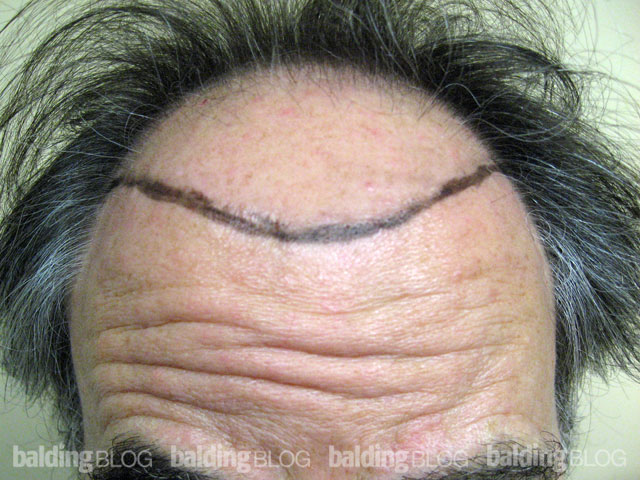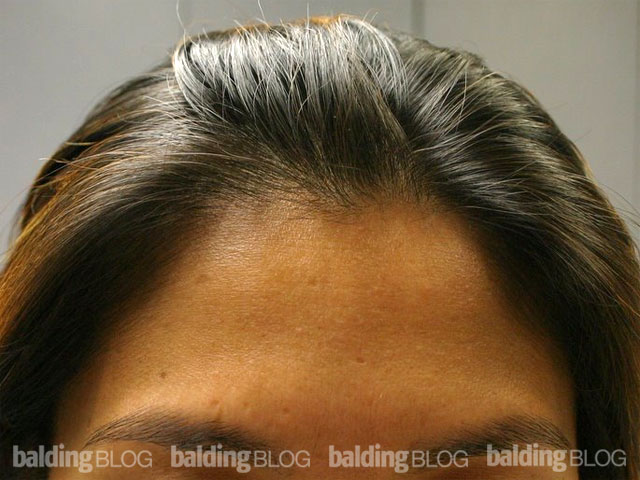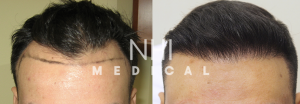Juvenile vs Mature Hairline — Am I Going Bald? (Photos)
Many of my younger readers of this blog are seeing changes in their hairlines and are worrying about becoming bald. The problem is made worse when there is balding in their family line. I have placed three diagrams taken from the Norwood Classification for hair loss. By conventional wisdom, the Class 1 pattern is proposed not to be balding, the Class 2 pattern suggests that this is the beginning of the balding pattern (it may actually be the beginning of the mature hairline, just not named as such), and the Class 3 pattern is thought of as early balding, possibly worthy of transplants in some men. The line between the Class 2 and 3 patterns are fuzzy, at best. The reality, however, is not quite as simple as I believe that Dr. O’Tar Norwood had documented. In most men (more so in Caucasians), the hairline of youth rises to a hairline of maturity. The mature hairline is about 1/2 to 3/4th inch higher in the middle than where the youthful hairline is and as one moves away from the midline to the corners of the hairline, the gap between the mature hairline location and the youthful hairline location is slightly over 1 inch, changing the overall shape of the hairline to its characteristic ‘V’ shape.
 |
 |
 |
 You can tell where your youthful hairline is/was by lifting your eyebrows up so that you can see your forehead wrinkle. I call this the furrowed brow, and the wrinkles you see reflect a muscle below the skin (the frontalis muscle which is present in everyone). The youthful (juvenile) hairline touches the top of the highest wrinkle of the furrowed brow and has a concave frontal shape to it. This often persist until the early teens, possibly longer. In the mature hairline (with its almost convex frontal shape (V-Shape) that extends from the temple prominences), shows a gap where there are no wrinkles and no hair present. None of what I just wrote is male pattern balding, yet many of our young readers panic when they see the rise in this hairline and they look to the Norwood Chart to identify where they are in the progression of their hair loss. It is particularly bothersome to the young men when the change occurs slowly and asymmetrically. Asymmetrical hair loss is common It’s even worse when the change produces a ‘chewed’ look. This maturing process occurs between 17 and 29 years of age and it is not uncommon to find one side go up faster than the other side. Not all men get a mature hairline (for example, former US President Bill Clinton retained his juvenile hairline — see his photo below) and retention of the juvenile hairline is more common in non-Caucasians as seen in many people from Asia and the middle eastern region.
You can tell where your youthful hairline is/was by lifting your eyebrows up so that you can see your forehead wrinkle. I call this the furrowed brow, and the wrinkles you see reflect a muscle below the skin (the frontalis muscle which is present in everyone). The youthful (juvenile) hairline touches the top of the highest wrinkle of the furrowed brow and has a concave frontal shape to it. This often persist until the early teens, possibly longer. In the mature hairline (with its almost convex frontal shape (V-Shape) that extends from the temple prominences), shows a gap where there are no wrinkles and no hair present. None of what I just wrote is male pattern balding, yet many of our young readers panic when they see the rise in this hairline and they look to the Norwood Chart to identify where they are in the progression of their hair loss. It is particularly bothersome to the young men when the change occurs slowly and asymmetrically. Asymmetrical hair loss is common It’s even worse when the change produces a ‘chewed’ look. This maturing process occurs between 17 and 29 years of age and it is not uncommon to find one side go up faster than the other side. Not all men get a mature hairline (for example, former US President Bill Clinton retained his juvenile hairline — see his photo below) and retention of the juvenile hairline is more common in non-Caucasians as seen in many people from Asia and the middle eastern region.
They say a picture is worth 1000 words, so look at the pictures and labels below for clarity of this. Women almost always retain their juvenile hairline through their entire lives, while 95% of Caucasian men develop a mature hairline.
Set 1 (below): Photo on the left is of a patient shown with the “mature” hairline drawn in. The photo in the middle on the right is of that same patient with the “juvenile” hairline drawn in (the lowest line paralleling the highest crease of the furrowed brow). Note the gap between the highest wrinkle and the proposed mature hairline. That ‘gap’ should not be transplanted. The photo on the below is of my hairline — a classic mature hairline. Click photos to enlarge.



Set 2 (below): Photos on the left (Korean) and on the right (Hispanic) non-transplanted hairline. The photo below this is of an adult female (Cambodian) hairline (non-transplanted). Mr. Clinton’s hairline (above) takes on the shape of the female hairline shown here. Female Hairline = Juvenile Male Hairline. Click photos to enlarge.



Weekend homework assignment: Check out the hairlines of your sibling, parents, spouse, neighbor, and meter maid. It’s worth looking at a variety of hairlines so that you can see what I’ve discussed above and determine the difference between a juvenile hairline and a mature hairline.



I just want to tell you that I appreciate you giving you time to provide us worry worts with this free basic information. It’s nice to see that doctors still care, and find importance of being informed without a charge!
You’re mostly right, but I noticed some statements that are not quite right. For example, a “mature” hairline technically is a form male pattern baldness; it is caused by the activity of DHT, involves thinning and loss of the hairline, and generally continues to recede and thin out even more throughout one’s life. While it is perfectly normal for the hairline to recede just a little bit at puberty, teenagers who notice their hairline becoming “mature” often go on to be totally bald in the front by their twenties (including myself). Also, I don’t think your statement about Middle Eastern men is correct. For one thing, they technically ARE caucasian, and not only that, but I go to a Lebanese Church and I would say that probably a majority of the men there are balding. One interesting observation though; most of them have the same pattern, where the front becomes a thin, high “peninsula” and the back has a big bald spot, although there are a couple guys there who are totally bald on top with only the side remaining.
Guy, I believe you are basing these ‘facts’ on your own experience – have you carried out empirical work in this area?
I’m interested in what Dr. Rassman means by the ‘chewed look’?
Many thanks for a great blog
Hey, i really liked this website, well, I\’m 28 and I still have my teenager\’s hairline, I had only a little hairloss on the sides you know the temple area but just a little bit you can\’t really tell, my grandfather is 80, and he had that v shaped hairline since he was 19, and still has it, well of course his hair is a lot thinner now, but he\’s not bald, my father always had a lot of hair, really thick hair and he had that same v shaped hairline and he is now 53 and ha s alot of hair, except that his was lower then my grandfather\’s, so I think the doctor is right about this! The main reason people go bald it’s because is in their genes or some hormones problems!
hey doc i need help with my hiar i dont know if am going to loss it from the frant i got a v shap cand. dont know much about hair loss so if you can send me photos are till me about hair loss in the frant let me know plzzzz send to me email addres its.adnkiller10@yahoo.com thx
its me mt corrit em is. adankiller10@yahoo.com
Thank you so much for the useful information. I guess I have more of a personal question:
I’m almost 19 and my hairline darts back to make the V shape. It’s been this way since I went through puberty and hasn’t been changing/receding since then. My dad has a nearly identical hairline to me and is now 49 and still has the same hairline he had in high school (the one I have now). My grandfather, according to my dad, had the same deal.
Do you think I will be lucky enough to follow this trend?
just wanted to second the statement J made, reassurance always helps.
The anti-spam word for this comment was “bald”. I take it that’s *not* a coincidence?
this is just swell, now i can sleep happily i though my receding hairline was going to keep on going im 19 so i figure i am just getting my mature hairline on. if not that his still a good security blanket and now i wont go bald from stress
I also do not with this mature hairline concept. I feel its still hairloss and is MPB so should be treated as such not ignored as it still impacts your appearance and not all men experience this.
It makes you look older and that is the entire point of caring about MPB in the first place.
Hey, thanks for this advice it has made me see things differently and helped subdue my panic :) seriously thank you.
I don’t think some of your information is 100% correct.
For example, I come from a Lebanese background, and not only did I start going bald in my teens, but several of my cousins are prematurely balding and many of the men at the local Lebanese church are balding as well, so your information about “Middle Eastern” men not going bald as often might not be accurate, or maybe it depends on where exactly these “Middle Eastern” mean are from (that is a very broad term).
Also, I don’t think the juvenile male hairline is the same as an adult female hairline; in my observation most women have a very round, but somewhat high hairline that curves down around the temples, whereas the juvenile male hairline is more of a cap that forms a low, but nearly straight line across the forehead and meets the temples at sort of a right angle. Some women also have a little bit of a widow’s peak that extends down from the center (while the temples remain covered).
Also, as I see someone else has already mentioned, the “mature” hairline is caused by the same hormones as a progressively receding hairline, and is basically the same thing; the difference is that for most men it slows down after puberty and changes so gradually that they don’t worry about it that much, becoming slightly more “mature”-looking with age until around the age of 40 or 50 when most men have some degree of noticeable hair loss (less common in some Asians and non-European Hispanics). This is part of the reason why you can often just glance at a person and guess their age (a 40-year-old typically has a more “mature” hairline than a 30-year-old, who generally has a more “mature” hair line than a 20-year-old.
My hairline started to look “mature” as soon as I hit puberty, but it just kept going, and by the time I was about 16 it become apparent that I was going prematurely bald. My senior portrait was awful, and I was wearing a hairpiece by the time I was 21.